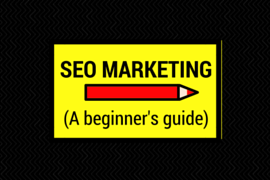 The first in a series of articles helping you get up to speed with SEO for your business, blog or cause.
The first in a series of articles helping you get up to speed with SEO for your business, blog or cause.
If you think you don’t need to know about SEO marketing, think again.
Search engines are the ultimate in targeted marketing. They direct people who are looking for what your website has to offer straight to your site – if you can get your name on that crucial first page of search results, of course.
93% of our online experiences begin with a search engine and 75% of users never scroll past the first page, according to statistics.
But how do you do you get your website on that first page? This is where SEO comes into play.
What is SEO marketing and why is it important?
SEO stands for Search Engine Optimisation.
Put simply, SEO marketing improves your website’s ranking in organic search engine results and drives traffic to your page.
Organic search results are basically the ones that are unpaid for. You can pay to get your website onto the first page of search engine results, but this is costly and according to research carried out by GroupM UK, 94% of users ignore the paid-for ads anyway.
What’s more, SEO leads have a 14.6% close rate (percentage of users who take the desired action on your website), while outbound leads (such as direct mail or print advertising) have a 1.7% close rate, The Search Engine Journal found.
This indicates that a solid SEO marketing strategy is key.
So how do search engines decide who gets to the top?
To understand how SEO works, you need to know about crawling and indexing.
Imagine that the internet is a vast, unmapped jungle of websites and their pages, which is constantly growing and evolving. In order to make sense of this jungle, search engines like Google and Bing release little robotic insects (nicknamed crawlers) to crawl around all the webpages and create maps of the internet. This is called indexing.
Theses crawlers need links to hop from webpage to webpage.
In order to appear in searches, your webpages need to be indexed by these crawlers, so you need to make your website as easy to navigate as possible, using links. Therefore it is important to structure your site in a way that is easy for crawlers and human users to navigate (more on that later).
The search engine then ranks all of these indexed web pages in order of what it deems the most valuable. SEO helps the search engines figure out what each page of your website is about and how it may be valuable for users.
How does the search engine determine a webpage’s value?
Search engines use hugely complicated algorithms with hundreds of criteria to work out how valuable your website is for us humans. But it all boils down to two main factors in the end:
- Relevance – is your site relevant to the search?
- Popularity – how popular is your site or page?
If you hit these two nails on the head, you’ve got a strong foundation for your SEO marketing strategy.
Where to start?
You need to cover the following bases in order to be indexed and ranked highly:
1. Structure your site in a way that is easy for crawlers and human users to navigate
- Organise the pages on your site in a clear, logical way. Use categories and sub-categories in your menu bar to create a navigation hierarchy. Don’t have too many – the trick is to need three or less clicks to reach every page of your website from the homepage.
- Your url structure should follow your navigation hierarchy. For example, say your business ‘shoes.com’ has a main category called ‘women’s shoes’ and a sub-category called ‘sandals’ plus a further sub-category called ‘high-heeled sandals.’ The url should read: http://www.shoes.com/womens-shoes/sandals/high-heeled-sandals in order for the crawlers to navigate to this page easily.
- Use html format so crawlers can read it, and provide alt text for images. For beginners, you can find out more about html and alt text here.
- Use internal linking – every page on your website should have some link to and some link from another page on the website.
2. Use keywords effectively
Think about any and every possible word that could be plugged into Google to search for a website like yours and you’ll have yourself a list of keywords. Even better, make use of the free Google Keyword Planner to see which of your words rank the highest and which other similar words and phrases people are searching for. Once you have a solid list of words, you can weave them into your website’s content, and they will help push your site up higher on the search engine. But be careful, too many keywords look like spam (called keyword-stuffing).
3. Quality content
Keep your content fresh and original – avoid regurgitating information that’s already out there, update it regularly, and make it useful information for searchers. Every time someone searches the internet they are looking to satisfy a need – to buy something, find a local business, answer a question, fix a problem, etc. Your content should aim to satisfy their search in an interesting, engaging way. Do this, and search engines will look on your website favourably.
Next time, we’ll explore the benefits that a blog can bring to your inbound marketing

Excellent introduction to seo marketing